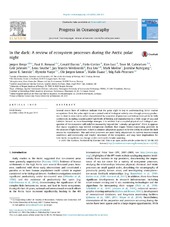| dc.contributor.author | Berge, Jørgen | |
| dc.contributor.author | Renaud, Paul | |
| dc.contributor.author | Darnis, Gérald | |
| dc.contributor.author | Cottier, Finlo | |
| dc.contributor.author | Last, Kim | |
| dc.contributor.author | Gabrielsen, Tove M. | |
| dc.contributor.author | Johnsen, Geir | |
| dc.contributor.author | Seuthe, Lena | |
| dc.contributor.author | Weslawski, Jan Marcin | |
| dc.contributor.author | Leu, Eva | |
| dc.contributor.author | Moline, Mark A. | |
| dc.contributor.author | Nahrgang, Jasmine | |
| dc.contributor.author | Søreide, Janne | |
| dc.contributor.author | Varpe, Øystein | |
| dc.contributor.author | Lønne, Ole Jørgen | |
| dc.contributor.author | Daase, Malin | |
| dc.contributor.author | Falk-Petersen, Stig | |
| dc.date.accessioned | 2016-03-01T08:47:49Z | |
| dc.date.available | 2016-03-01T08:47:49Z | |
| dc.date.issued | 2015-08-28 | |
| dc.Published | Progress in Oceanography 2015 | eng |
| dc.identifier.issn | 0079-6611 | en_US |
| dc.identifier.uri | http://hdl.handle.net/1956/11409 | |
| dc.description.abstract | Several recent lines of evidence indicate that the polar night is key to understanding Arctic marine ecosystems. First, the polar night is not a period void of biological activity even though primary production is close to zero, but is rather characterized by a number of processes and interactions yet to be fully understood, including unanticipated high levels of feeding and reproduction in a wide range of taxa and habitats. Second, as more knowledge emerges, it is evident that a coupled physical and biological perspective of the ecosystem will redefine seasonality beyond the “calendar perspective”. Third, it appears that many organisms may exhibit endogenous rhythms that trigger fitness-maximizing activities in the absence of light-based cues. Indeed a common adaptation appears to be the ability to utilize the dark season for reproduction. This and other processes are most likely adaptations to current environmental conditions and community and trophic structures of the ecosystem, and may have implications for how Arctic ecosystems can change under continued climatic warming. | en_US |
| dc.language.iso | eng | eng |
| dc.publisher | Elsevier Ltd. | en_US |
| dc.rights | Attribution CC BY-NC-ND 4.0 | eng |
| dc.rights.uri | http://creativecommons.org/licenses/by-nc-nd/4.0/ | eng |
| dc.subject | ecosystem | eng |
| dc.subject | Arctic polar night | eng |
| dc.title | In the dark: a review of ecosystem processes during the Arctic polar night | en_US |
| dc.type | Peer reviewed | |
| dc.type | Journal article | |
| dc.date.updated | 2015-12-29T14:00:58Z | |
| dc.description.version | publishedVersion | en_US |
| dc.rights.holder | Copyright 2015 The Authors | en_US |
| dc.identifier.doi | https://doi.org/10.1016/j.pocean.2015.08.005 | |
| dc.identifier.cristin | 1276912 | |
| dc.relation.project | Norges forskningsråd: 195160 | |
| dc.relation.project | Norges forskningsråd: 226417 | |
| dc.relation.project | Norges forskningsråd: 223254 | |
| dc.relation.project | Norges forskningsråd: 214271 | |
| dc.relation.project | Norges forskningsråd: 244319 | |
| dc.subject.nsi | VDP::Matematikk og Naturvitenskap: 400 | en_US |

